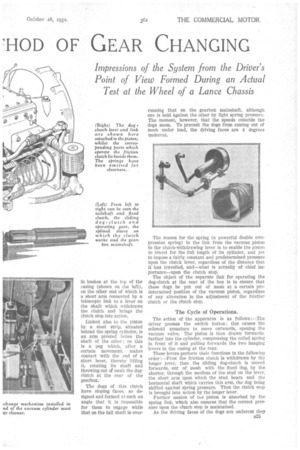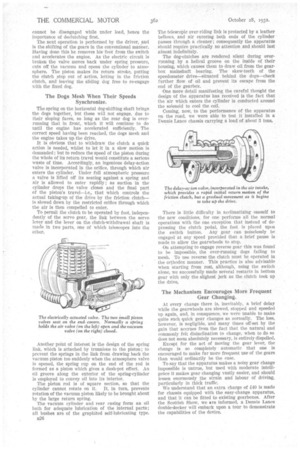A NEW AND PROMISING ME 'HOD OF GEAR CHANGING
Page 50

Page 51

Page 52

If you've noticed an error in this article please click here to report it so we can fix it.
THE present time, when pre-selective and easychanging gears are arousing widespread interest, seems most opportune for the introduction of an entirely new mechanism of this kind. We are now able to announce that an interesting system possessing the great advantages of simplicity and low cost has
been introduced by that well-known maker, Dennis Bros., Ltd., of Guildford.
Proof of its merits is forthcoming from several important operators which have had it under test, and we ourselves have tried it and found the apparatus to do all that is claimed for it by the maker.
Before describing our impressions of the device in actual service an explanation of its method of functioning, and of the construction of its mechanism, will enable its performance to be the better appreciated. It should be clearly understood that the device does not incorporate a free wheel.
How the System Functions.
The principle involved is to disconnect the gearbox at both front and rear, to bring all the gearwheels to a standstill and to make the desired change with the wheels stationary. This is accomplished by means of the orthodox clutch at tile front and by a special type of dog-clutch at the rear, whilst the wheels are slowed by the clutch stop. The power required to perform these three operations is provided by a vacuum cylinder brought into action by what is, perhaps, the simplest form of control in existence—an electric push-switch.
The vacuum cylinder, the bore and stroke of which are of considerable magnitude, in order to provide certain operationeven when the vacuum is low, is mounted on a plate bolted to the off side of the gearbox. Only its front end operates, the rear end being open.
The iron casting seen in the line drawing on this page at the right of the cylinder contains a valve which is actuated by a solenoid. Pressure on the switch, which is normally operated by the driver's left foot, but which can equally well be worked by his right foot or, if the switch be incorporated in the gear-lever
knob, by hand, allows current to flow through the coil of the solenoid (designed to take 8 amps.) ; this induces a 15 lb. pull on the armature, which moves across (towards the eye, in the drawing), cutting off the passage from the vacuum cylinder to atmosphere and putting it in direct connection with the pipe-line to the induction pipe.
On the flow of current ceasing, the armature and the moving portion of the valve return under the influence of a spring, cutting off the vacuum and allowing air to enter the cylinder through a delay-action valve and an air cleaner.
The piston in the vacuum cylinder, which is returned by a coiled spring in the vacuum end, is linked by a cylindrical spring box to the arm of a short shaft carried
in bushes at the top of the casing (shown on the left), on the other end of which is a short arm connected by a telescopic link to a lever on the shaft which withdraws the clutch and brings the clutch stop into action.
Linked also to the piston by a steel strip, situated behind the spring cylinder, is an arm pivoted below the shaft of the other ; on this is a peg which, after a certain movement, makes contact with the end of a short lever, thereby lifting it, rotating its shaft and throwing out at mesh the dogclutch at the rear of the gearbox.
The dogs of this clutch have sloping faces, so designed and formed at such an angle that it is impossible for them to engage while that on the tail shaft is over The reason for the spring (a powerful double compression spring) in the link from the vacuum piston to the clutch-withdrawing lever is to enable the piston to travel for the full length of its cylinder, and yet to impose a fairly constant and predetermined pressure upon the clutch lever, regardless of the distance that it has travelled, and—what is actually of chief hnportance—upon the clutch stop.
The object of the separate link for operating the dog-clutch at the rear of the box is to ensure that these dogs be put out of mesh at a certain predetermined position of the vacuum piston, regardless of any alteration in the adjustment of the friction clutch or the clutch stop.
The Cycle of Operations.
The action of the apparatus is as follows :—The driver presses the switch button; this causes the solenoid armature to move outwards, opening the vacuum valve. The piston is then drawn forwards, farther into the cylinder, compressing the coiled spring in front of it and pulling forwards the two hanging levers in the casing at the rear.
These levers perform their functions in the following order :—First the friction clutch is withdrawn by the longer lever, then the sliding dog-clutch is moved forwards, out of mesh with the fixed dog, by the shorter, through the medium of the stud on the lever, the short arm upon which the stud bears and the horizontal shaft which carries this arm, the dog being shifted against spring pressure. Then the clutch stop is brought into action by the longer lever.
Further motion of the piston is absorbed by the spring link, which also ensures that the correct pressure upon the clutch stop is maintained.
As the driving faces of the dogs are undercut they B25 cannot be disengaged while under load, hence the importance of declutching first.,
The next operation is performed by the driver, and is the shifting of the gears in the conventional manner. Having done this he removes his footfrom the switch and accelerates the engine. As the electric circuit is broken the valve moves back under spring pressure, cuts off the vacuum and opens the cylinder to atmosphere. The piston makes its return stroke, putting the clutch stop out of action, letting in the friction clutch, andleaving the sliding dog free to re-engage with the fixed dog.
The Dogs Mesh When Their Speeds Synchronize.
The spring on the horizontal dog-shifting shaft brings the dogs together, but these will not engage, due to their sloping faces, so long as the rear dog is overrunning that in front, which it will continue to do until the engine has accelerated sufficiently. The correct speed having been reached, the dogs mesh and the engine takes up-the drive.
It is obvious that to withdraw the -clutch a quick action is needed, whilst to let it in a slow motion is demanded ; but to reduce the speed of the piston during the whole of its return travel would constitute a serious waste of time. Accordingly, an ingenious delay-action valve is incorporated in the orifice, through which air enters the cylinder. Under full atmospheric pressure a valve is lifted off its seating against a spring and air is allowed to enter rapidly ; as suction in the cylinder drops the valve closes and the final part of the piston's travel—i.e., that which controls the actual taking-up of the drive by the friction clutch— is slowed down by the restricted orifice through which the air is then compelled to enter.
To permit the clutch to be operated by foot, independently of the servo gear, the link between the servo lever and the lever on the clutch-withdrawal shaft is made in two parts, one of which telescopes into the other.
Another point of interest is the design of the spring link, which is attached by trunnions to the piston; to prevent the springs in the link from drawing back the vacuum piston too suddenly when the atmosphere valve is opened, the spring cup on the end of the rod is formed as a piston which gives a dash-pot effect. An oil groove along the exterior of the spring-cylinder is employed to convey oil into its interior.
The piston rod is of square section, so that the cylinder cannot rotate on it. It, in turn, prevents rotation of the vacuum piston likely to be brought about by the large return spring.
The vacuum cylinder and rear casing form an oil bath for adequate lubrication of the internal parts ; all bushes are of the graphited self-lubricating type.
B26 The telescopic over-riding link is protected by a leather bellows, and air entering both ends of the cylinder passes throtigh a cleaner; consequently the apparatus should require practically no attention and should last almost indefinitely.
The dog-clutches are rendered silent during overrunning by a helical groove on the inside of their housing, which causes them to draw oil from the gearbox .mainshaft bearing. The skew-teeth of the speedometer drive—situated behind the dogs—check further flow of oil and prevent its escape from the end of the gearbox.
One more detail manifesting the careful thought the design of the apparatus has received is the fact that the air which enters the cylinder is conducted around the solenoid to cool the coil.
Coming, now, to the performance of the apparatus on the road, we were able to test it installed in a Dennis Lance chassis carrying a load of about 3 tens..
There is little difficulty in acclimatizing oneself to the new conditions, for one performs all the normal operations with the one exception that instead of depressing the clutch pedal, the foot is placed upon the switch button. Any gear can noiselessly be engaged at any speed provided that a brief pause is made to allow the gearwheels to stop.
On attempting to engage reverse gear this was found to be impossible, the over-running dogs failing to mesh. To use reverse the clutch must be operated in the orthodox manner. This practice is also advisable when starting from rest, although, using the switch alone, we successfully made several restarts in bottom gear with only the slighest jerk as the clutch took up the drive,
The Mechanism Encourages More Frequent .Gear Changing.
At every change there is, inevitably, a brief delay while the gearwheels are slowed, stopped and speeded lip again, and, in consquence,. we were unable to Make quite such quick gear changes as normally. The loss, however, is negligible, and many times off-set by the gain that accrues from the feet that the natural and commonly felt disinclination to change, when to do so does not seem absolutely necessary, is entirely dispelled.
Except for the act of moving the gear lever, the change is so completely automatic that one is encouraged to make far more frequent use of the gears than would ordinarily be the case.
To say that the apparatus makes a noisy gear change impossible is untrue, hut used with moderate intelligence it makes gear changing vastlY easier, and should lessen enormously the strain and labour of driving, particularly in thick traffic.
We understand that an extra charge of 140 is made for chassis equipped with the easy-change apparatus, and that it Can be fitted to existing gearboxes. After the Scottish Show, we are informed, a Dennis Lance double-decker will embark upon a tour to demonstrate the capabilities of the device.






































































































